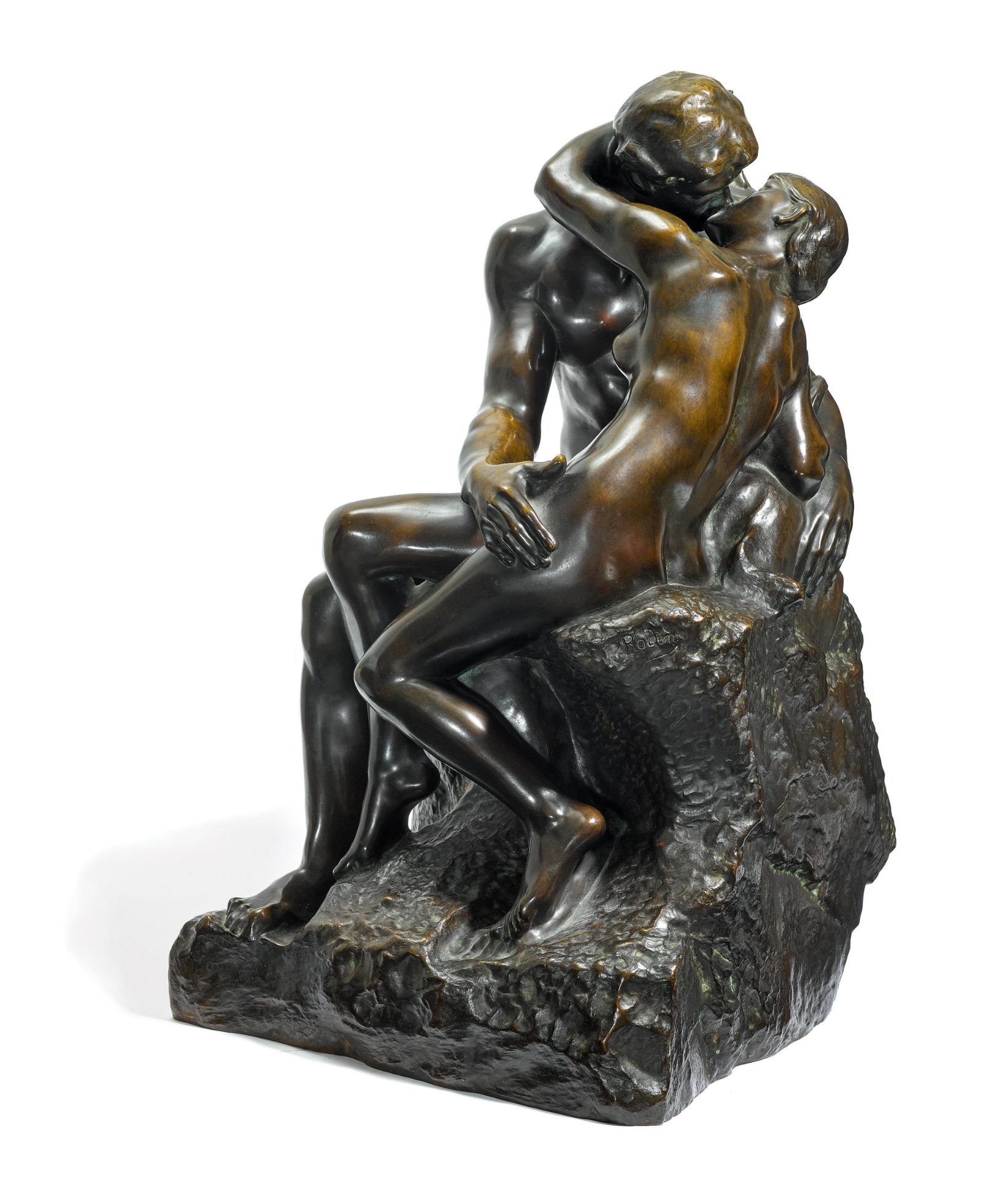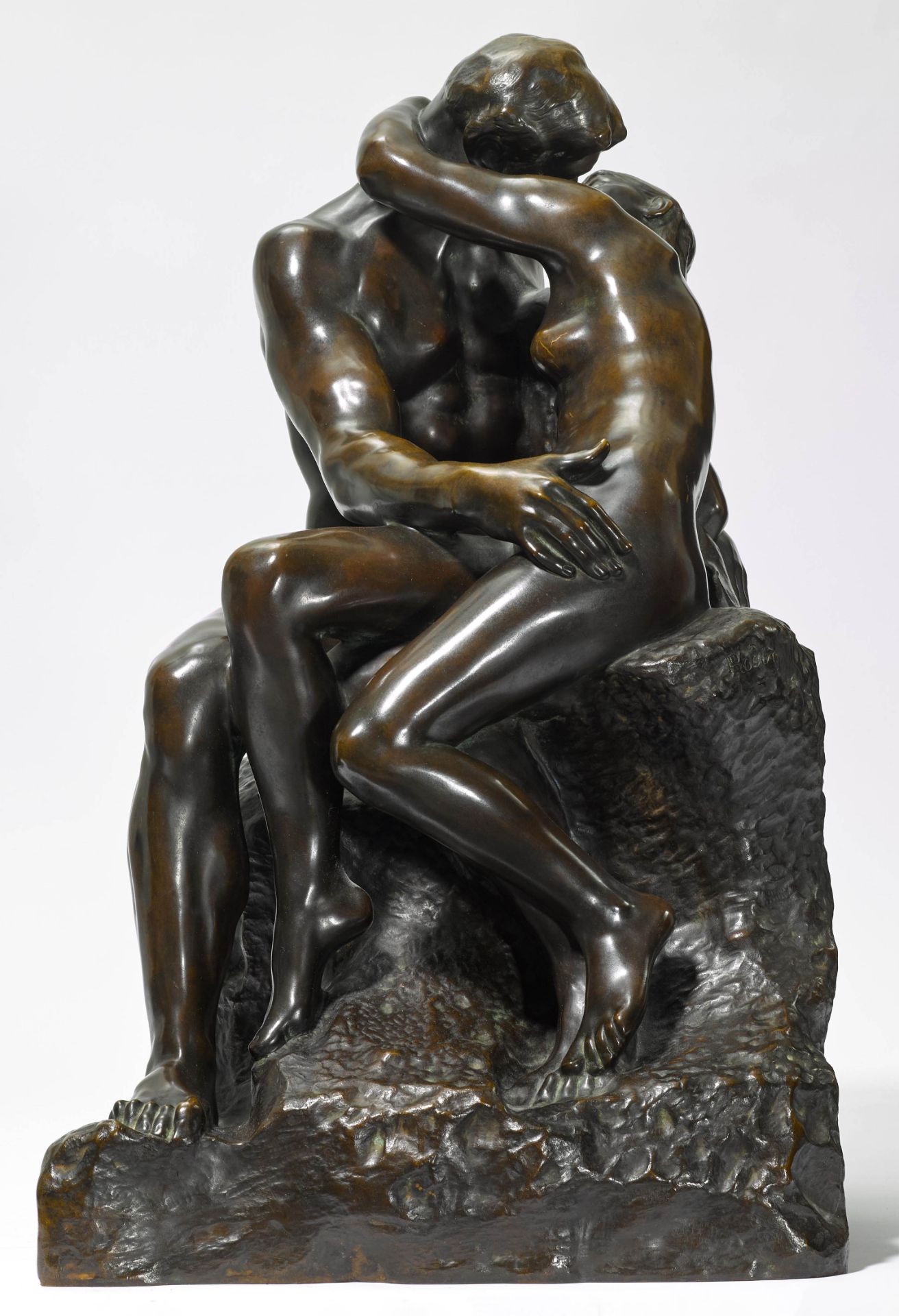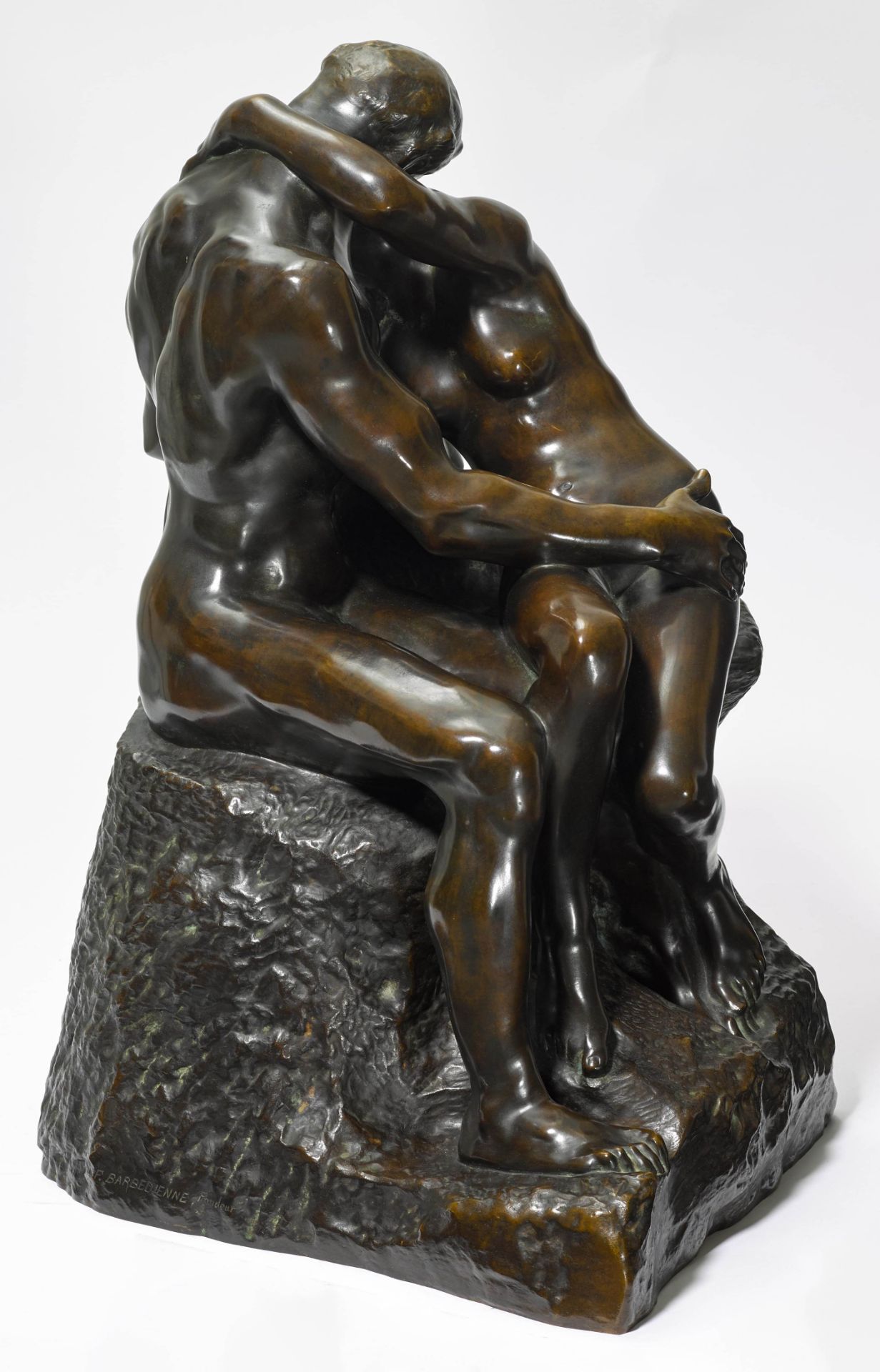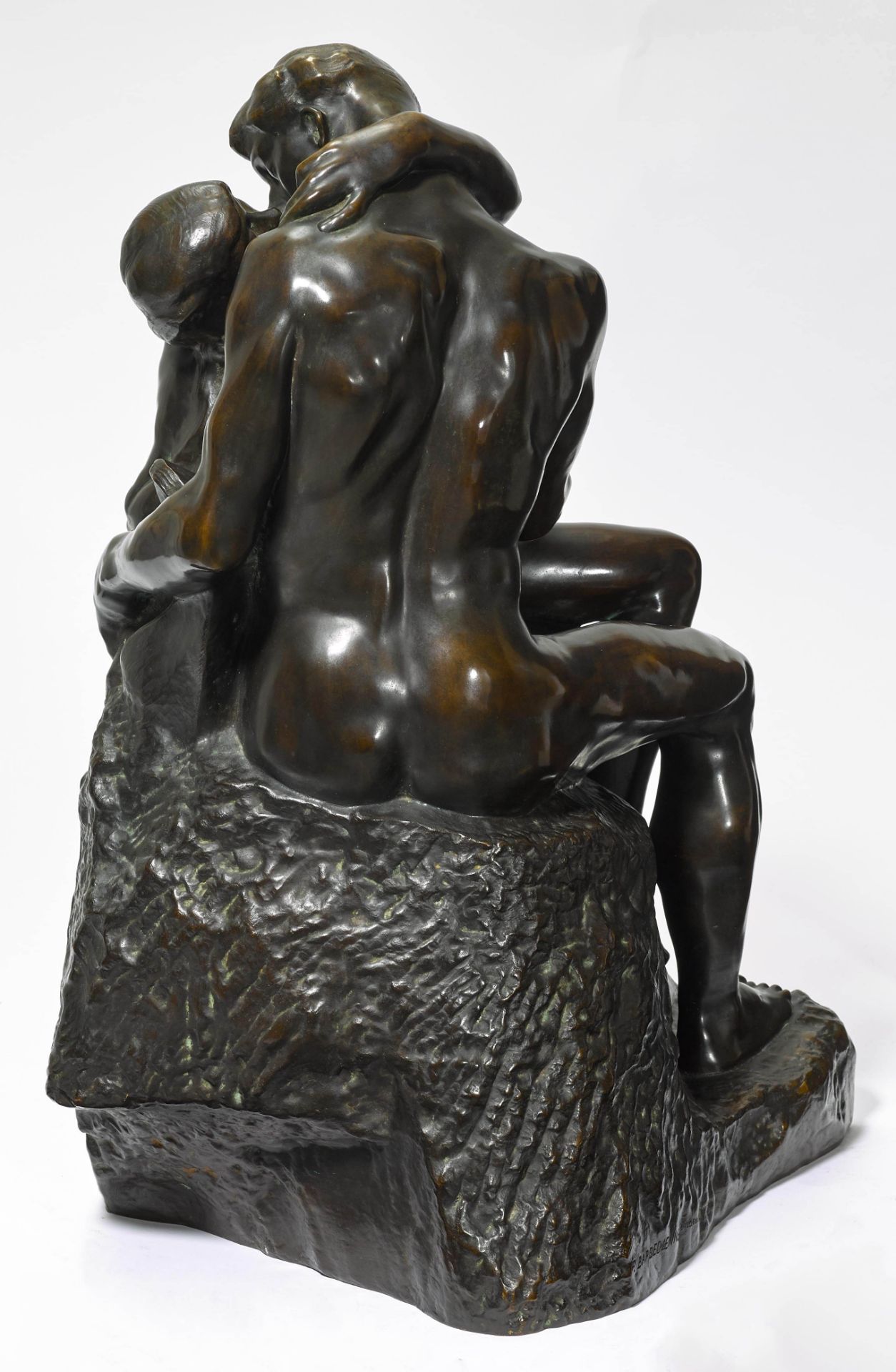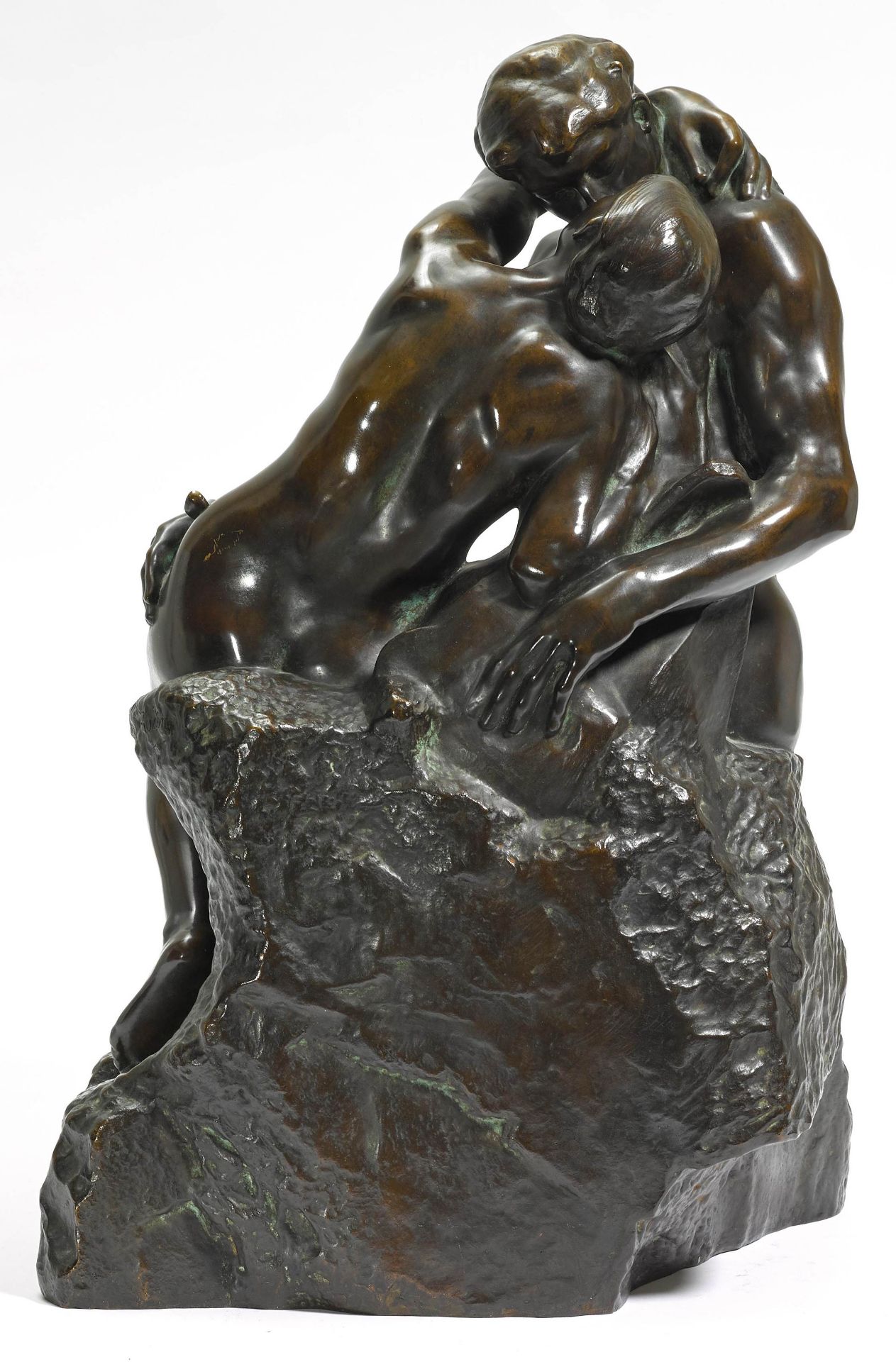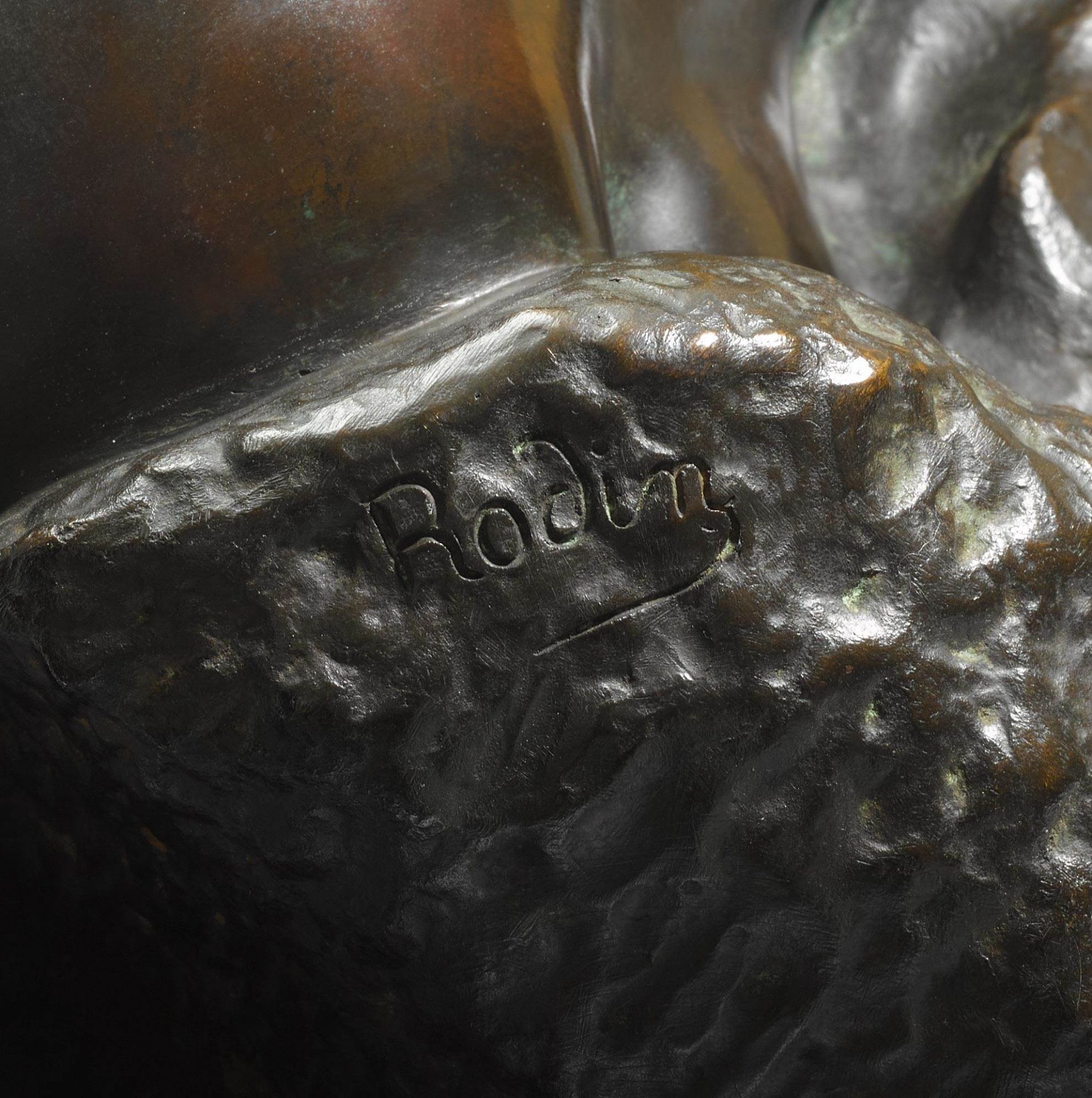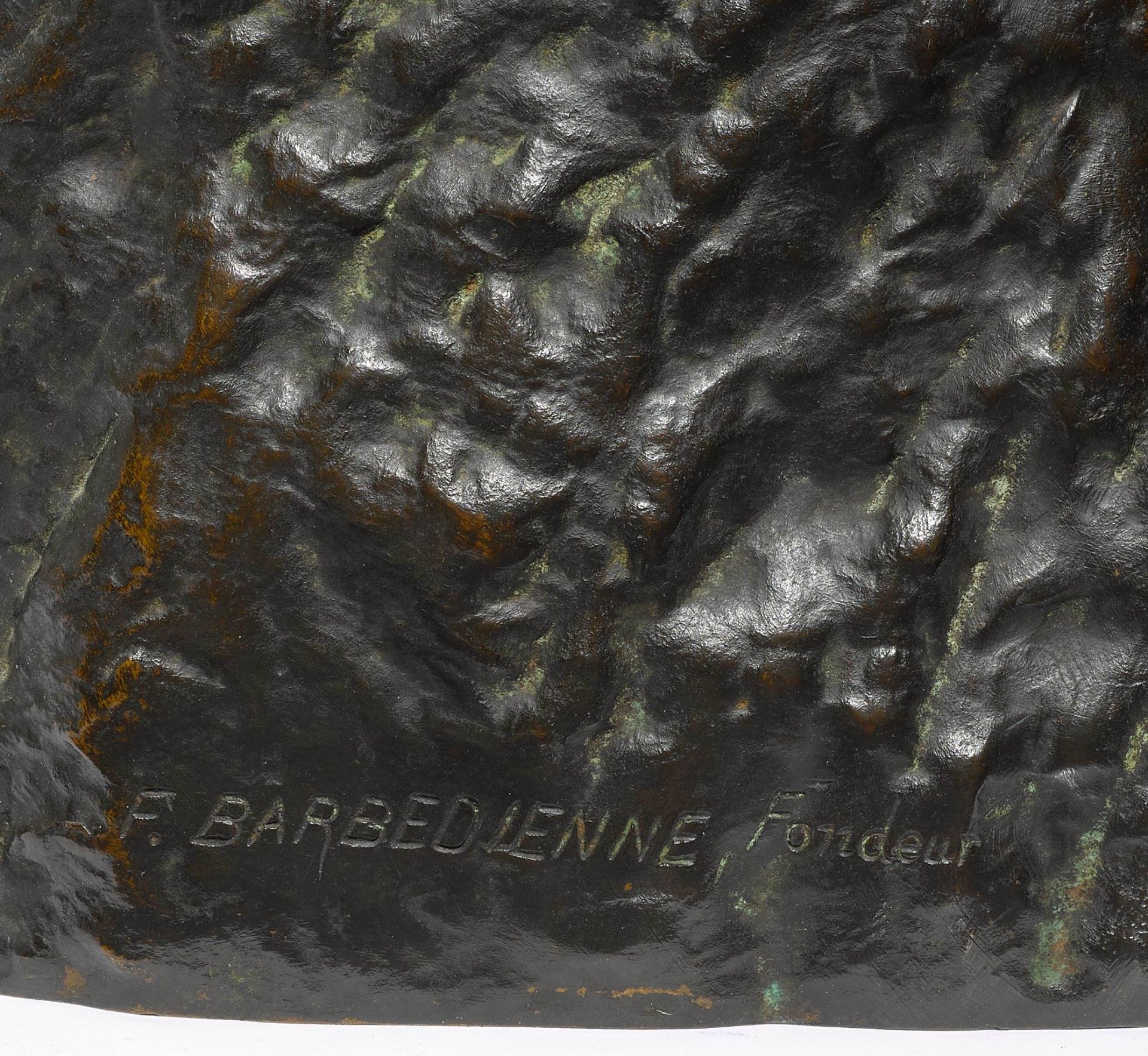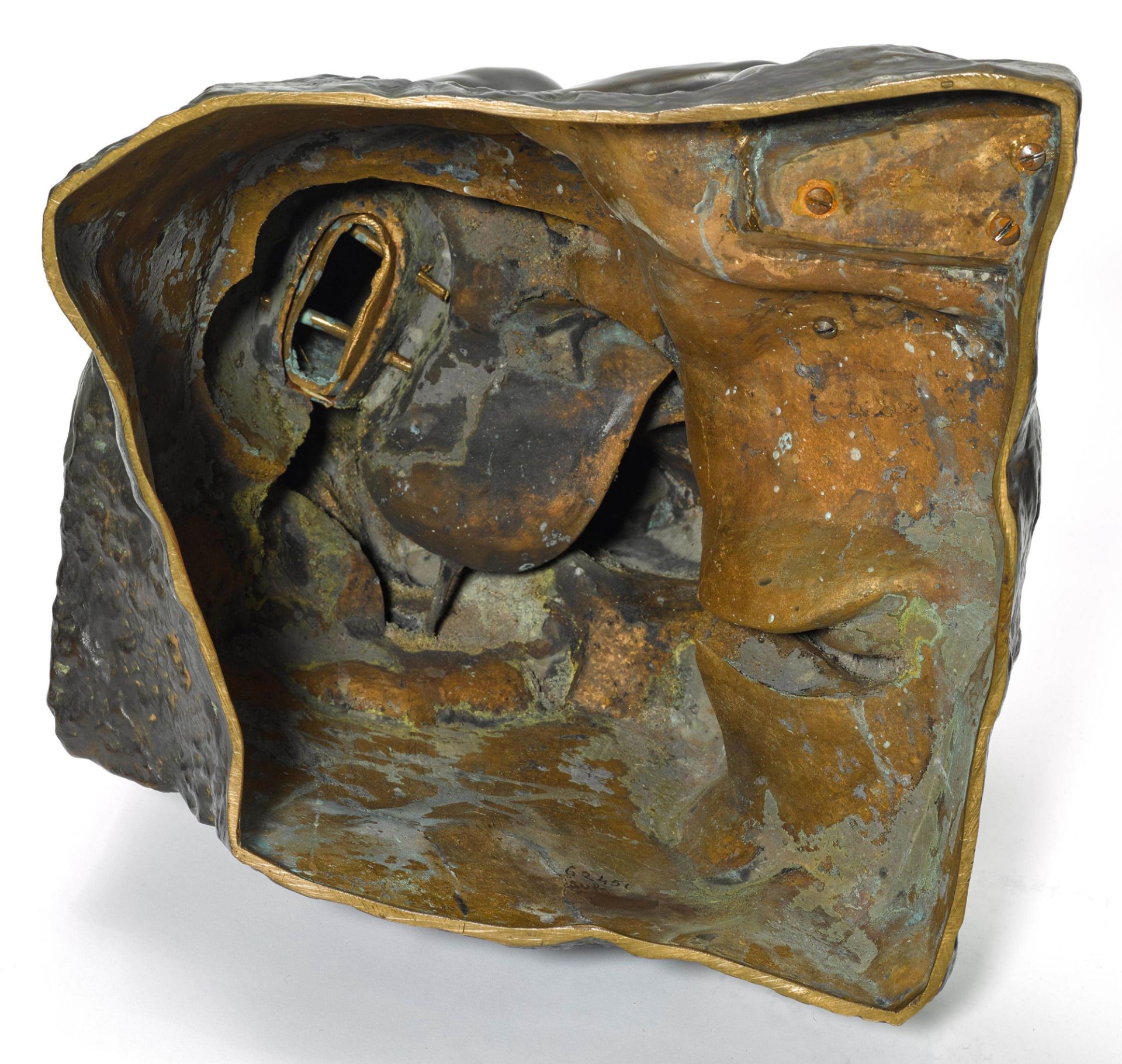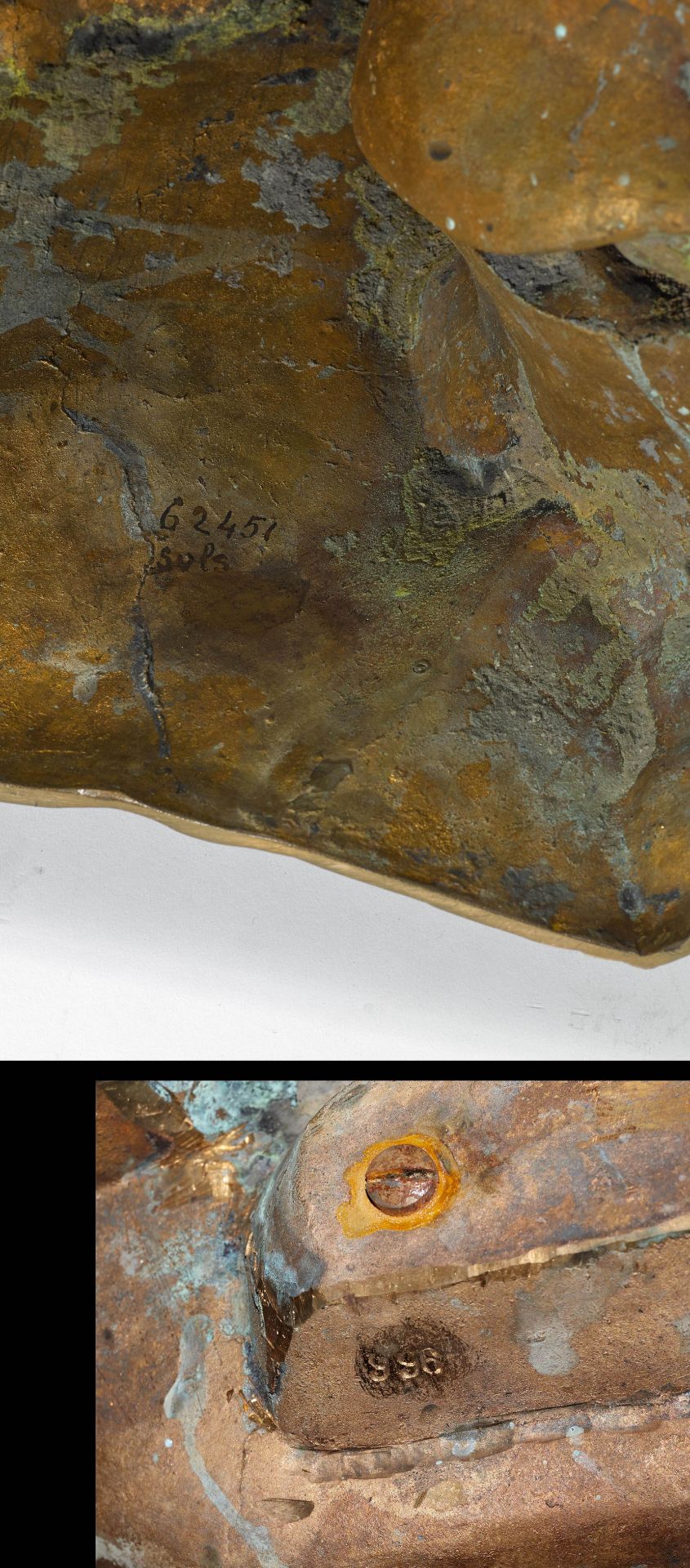3218
AUGUSTE RODIN
(Paris 1840–1917 Meudon)
Le Baiser (The Kiss). 2ème réduction dite aussi "réduction n°4". 1886. Cast on 8 June 1905.
Bronze, brown patina.
Signed in the centre on the right: Rodin. Lower left with the foundry mark: F. Barbedienne. Fondeur. Inside with the engraved numbers "996" and three times "9", the letter "D" on the edge and the numbering in ink "62451 gulg".
H 59.8 cm.
We would like to thank the Galerie Brame & Lorenceau, François Lorenceau and Jérôme Le Blay, for confirming the authenticity of the work, Paris, 28 February 2021. It will be registered under number 2021-6289B and will be included in the catalogue critique de l'œuvre sculpté d’Auguste Rodin currently in preparation. Provenance: Swiss private collection, acquired in Paris between 1905 and 1910 and since then owned by the same family. Literature: - Antoinette Le Normand-Romain: The Bronzes of Rodin, Catalogue of Works in the Musée Rodin, Paris 2007, vol. I, no. p. 776 (with ill. another cast p. 161). - Georges Grappe: Catalogue du Musée Rodin, Paris 1927 (with ill. of the marble p. 47). - Georges Grappe: Le Musée Rodin, Paris 1947 (with ill. of the marble p. 71). - Cécile Goldscheider: Rodin, sa vie, son œuvre, son héritage, Paris 1962 (with ill. of the marble). - Albert E. Else: Rodin, London 1963, S. 63 (with ill. another cast). - Bernard Champigneulle: Rodin, London 1967 (with ill. of the marble p. 162/163). - Robert Descharnes and Jean François Chabrun: Auguste Rodin, Lausanne 1967 (with ill. of the marble p. 54/55). - Ionel Jianou and Cécile Goldscheider: Rodin, Paris 1967 (with ill. of the marble p. 54/55). - Ludwig Goldscheider: Rodin Sculptures, London 1970 (with ill. of the marble p. 121). - John L. Tancock: The Sculpture of Auguste Rodin, Philadelphia 1976 (with ill. of the marble p. 77). - Jacques de Caso and Patricia Sanders: Rodin's Sculpture, A Critical Study of the Spreckels Collection, California Palace of the Legion of Honor, San Francisco 1977, p. 150 (with ill. another cast). - Nicole Barbier: Marbres de Rodin, collection du musée, Paris 1987 (with ill. of the marble p. 186/187). - Antoinette Le Normand-Romain: Le Baiser de Rodin/The Kiss by Rodin, Paris 1995 (with ill. another cast fig. 3). - Antoinette Le Normand-Romain: Rodin, Paris 1997 (with ill. of the terracotta p. 48). - Albert E. Else: Rodin's Art, The Rodin Collection of the Iris & B. Gerald Cantor Center for the Visual Arts at Stanford University, New York 2003 (with ill. another cast p. 214/215). ‘Le Baiser’ was originally planned as part of Auguste Rodin's project for ‘The Gates of Hell’. The sculpture was conceived as one of the first groups, developed between 1880 and 1882, and was to be attached to the left wing of the monumental gate. The depicted couple is inspired by the story of the forbidden love between Francesca da Rimini and Paolo Malatesta, as related in the second circle of hell in Dante’s Inferno from his Divine Comedy. Although Francesca was already married to Giovanni Malatesta, Paolo's older brother, the two fall in love while reading together. According to the tale, the lovers are discovered by Francesca's husband in the midst of their first kiss. Enraged by the betrayal of his brother and his wife, he murders Francesca and Paolo, condemning the lovers to an eternity spent in hell. In his sculpture, Rodin has captured the intimate moment of their first kiss. The sculpture’s beauty and expression of tender love was incongruous with the tragic intensity that the artist envisioned for his ‘Gates of Hell’ and in 1886 Rodin decided to separate ‘Le Baiser’ from the canon of the 'Gates of Hell' and to make it an independent sculpture. While Rodin’s ‘Le Baiser’ was still scandalous at its first exhibition in 1887 at the Galerie Georges Petite, the sculpture celebrated enormous success at subsequent exhibitions and proved to be greatly popular among the viewing public. This breakthrough led Rodin to sign a ten-year contract with the Leblanc-Barbedienne foundry in 1898 for the reproduction of his models ‘L’Eternal Printemps’ and ‘Le Baiser’. ‘Le Baiser’ was initially produced in edition sizes of 71 cm and 25 cm, then size 40 cm from 1901 onward and the "deuxième réduction" of 60 cm was finally cast in bronze from 1904 onward. Approximately 65–68 examples of this size were cast between 1904 and 1918. The contract stipulated that Rodin would receive a 20% commission on the sale of each sculpture. The sculptures were each inscribed on the inside with a number code in ink, indicating the date of production. In most cases, this number is no longer visible due to decades of wear and it is therefore not possible to exactly determine the casting year for most of the bronzes. Our model is one of the very rare examples in which the ink code on the inside is still in excellent condition. The sculpture was produced on 8 June 1905, and is one of the earliest casts of this size. The original sales invoice for this copy is in the Musée Rodin in Paris. The present ‘Le Baiser’ was acquired in Paris between 1905 and 1910 by the great-great-grandfather of the current owners and has remained in the same family for more than 100 years. Today ‘Le Baiser’ is one of the most famous works by Rodin and one of the most iconic sculptures in the history of art.
(Paris 1840–1917 Meudon)
Le Baiser. 2ème réduction dite aussi "réduction n°4". 1886. Guss vom 8. Juni 1905.
Bronze, braune Patina.
Mittig rechts signiert: Rodin. Unten links mit dem Giesserstempel: F. Barbedienne. Fondeur. Innen mit den eingravierten Nummerierungen "996" und dreimal "9", der Bezeichnung "D" am Rand und der Nummerierung in Tinte "62451 gulg".
H 59,8 cm.
Wir danken der Galerie Brame & Lorenceau, François Lorenceau und Jérôme Le Blay, für die Bestätigung der Authentizität des Werks, Paris, 28. Februar 2021. Es wird unter der Nummer 2021-6289B in den sich in Vorbereitung befindenden Catalogue critique de l'œuvre sculpté d’Auguste Rodin aufgenommen. Provenienz: Schweizer Privatbesitz, zwischen 1905 und 1910 in Paris erworben und seitdem im gleichen Familienbesitz. Literatur: - Antoinette Le Normand-Romain: The Bronzes of Rodin, Catalogue of Works in the Musée Rodin, Paris 2007, Bd. I, Nr. S. 776 (mit Abb. anderer Guss S. 161). - Georges Grappe: Catalogue du Musée Rodin, Paris 1927 (mit Abb. des Marmors S. 47). - Georges Grappe: Le Musée Rodin, Paris 1947 (mit Abb. des Marmors S. 71). - Cécile Goldscheider: Rodin, sa vie, son œuvre, son héritage, Paris 1962 (mit Abb. des Marmors). - Albert E. Else: Rodin, London 1963, S. 63 (mit Abb. anderer Guss). - Bernard Champigneulle: Rodin, London 1967 (mit Abb. des Marmors S. 162/163). - Robert Descharnes und Jean François Chabrun: Auguste Rodin, Lausanne 1967 (mit Abb. des Marmors S. 54/55). - Ionel Jianou und Cécile Goldscheider: Rodin, Paris 1967 (mit Abb. des Marmors S. 54/55). - Ludwig Goldscheider: Rodin Sculptures, London 1970 (mit Abb. des Marmors S. 121). - John L. Tancock: The Sculpture of Auguste Rodin, Philadelphia 1976 (mit Abb. des Marmors S. 77). - Jacques de Caso und Patricia Sanders: Rodin's Sculpture, A Critical Study of the Spreckels Collection, California Palace of the Legion of Honor, San Francisco 1977, S. 150 (mit Abb. anderer Guss). - Nicole Barbier: Marbres de Rodin, collection du musée, Paris 1987 (mit Abb. des Marmors S. 186/187). - Antoinette Le Normand-Romain: Le Baiser de Rodin/The Kiss by Rodin, Paris 1995 (mit Abb. anderer Guss Fig. 3). - Antoinette Le Normand-Romain: Rodin, Paris 1997 (mit Abb. des Terracottas S. 48). - Albert E. Else: Rodin's Art, The Rodin Collection of the Iris & B. Gerald Cantor Center for the Visual Arts at Stanford University, New York 2003 (mit Abb. anderer Guss S. 214/215). “Le Baiser” war ursprünglich als Teil von Auguste Rodins Höllentor geplant. Die Figur entsteht als eine der ersten Skulpturengruppen, wird zwischen 1880 und 1882 ausgearbeitet und sollte am linken Flügel des monumentalen Tors angebracht werden. Das dargestellte Paar basiert auf der Geschichte der verbotenen Liebe zwischen Francesca da Rimini und Paolo Malatesta, von der Dante im zweiten Höllenkreis des Infernos seiner göttlichen Komödie berichtet. Obwohl Francesca bereits mit Giovanni Malatesta, dem älteren Bruder Paolos, verheiratet ist, verlieben sie und Paolo sich während des gemeinsamen Lesens ineinander. Laut Überlieferung küssen sich die Liebenden zum ersten Mal, als der Ehemann von Francesca die beiden erwischt. In Rage über den Verrat seines Bruders und seiner Frau ermordet er das Liebespaar. Von dort an sind Francesca und Paolo verdammt zur Ewigkeit in der Hölle. Rodin stellt in seiner Skulptur diesen intimen Moment des ersten Kusses dar. Die liebliche Botschaft und die Schönheit dieser Skulptur sind dem Künstler für sein Höllentor schliesslich doch zu wenig tragisch, weswegen sich Rodin 1886 dazu entschliesst, „Le Baiser“ vom Kanon des Höllentors zu trennen und eine eigenständige Skulptur daraus zu machen. Galt der Kuss auf der ersten Ausstellung 1887 in der Galerie Georges Petit noch als skandalös, feierte „Le Baiser“ bei den darauffolgenden Ausstellungen einen enormen Erfolg und erfreute sich beim Ausstellungspublikum grosser Beliebtheit. Aufgrund dieses Durchbruchs schloss Rodin 1898 einen 10-Jahresvertrag mit der Giesserei Leblanc-Barbedienne über die Reproduktion seiner Modelle „L’Eternal Printemps“ und „Le Baiser“ ab. Zuerst erschien der Kuss in den Grössen 71 cm und 25 cm, ab 1901 dann in der Grösse 40 cm und ab 1904 wurde schliesslich die „deuxième réduction“ von 60 cm in Bronze gegossen. Von dieser Grösse wurden zwischen 1904 und 1918 ca. 65–69 Exemplare gegossen. Vertraglich war geregelt, dass Rodin für den Verkauf jeder Skulptur eine Provision von 20 % erhalten soll. Die Skulpturen wurden jeweils im Innern mit einem Nummerncode in Tinte beschriftet, der für das Datum der Entstehung steht. In den meisten Fällen ist diese Nummer durch die jahrzehntelange Abnutzung nicht mehr ersichtlich und deshalb ist bei den meisten Bronzen nicht genau nachvollziehbar, wann sie gegossen worden sind. Unser Modell ist eines der sehr seltenen Exemplare, bei dem der Tintencode im Innern noch hervorragend erhalten ist. Die Skulptur ist auf den Tag genau am 8. Juni 1905 entstanden und ist somit einer der frühesten Abgüsse dieser Grösse. Die ursprüngliche Verkaufsrechnung zu diesem Exemplar befindet sich im Musée Rodin in Paris. Der vorliegende „Le Baiser“ wurde zwischen 1905 und 1910 vom Ur-Ur-Grossvater der heutigen Besitzer in Paris erworben und blieb bis heute, seit mehr als 100 Jahren, im gleichen Familienbesitz. Heute zählt die Skulptur zu den berühmtesten Werken Rodins und ist eine der bekanntesten Plastiken überhaupt.
(Paris 1840–1917 Meudon)
Le Baiser (The Kiss). 2ème réduction dite aussi "réduction n°4". 1886. Cast on 8 June 1905.
Bronze, brown patina.
Signed in the centre on the right: Rodin. Lower left with the foundry mark: F. Barbedienne. Fondeur. Inside with the engraved numbers "996" and three times "9", the letter "D" on the edge and the numbering in ink "62451 gulg".
H 59.8 cm.
We would like to thank the Galerie Brame & Lorenceau, François Lorenceau and Jérôme Le Blay, for confirming the authenticity of the work, Paris, 28 February 2021. It will be registered under number 2021-6289B and will be included in the catalogue critique de l'œuvre sculpté d’Auguste Rodin currently in preparation. Provenance: Swiss private collection, acquired in Paris between 1905 and 1910 and since then owned by the same family. Literature: - Antoinette Le Normand-Romain: The Bronzes of Rodin, Catalogue of Works in the Musée Rodin, Paris 2007, vol. I, no. p. 776 (with ill. another cast p. 161). - Georges Grappe: Catalogue du Musée Rodin, Paris 1927 (with ill. of the marble p. 47). - Georges Grappe: Le Musée Rodin, Paris 1947 (with ill. of the marble p. 71). - Cécile Goldscheider: Rodin, sa vie, son œuvre, son héritage, Paris 1962 (with ill. of the marble). - Albert E. Else: Rodin, London 1963, S. 63 (with ill. another cast). - Bernard Champigneulle: Rodin, London 1967 (with ill. of the marble p. 162/163). - Robert Descharnes and Jean François Chabrun: Auguste Rodin, Lausanne 1967 (with ill. of the marble p. 54/55). - Ionel Jianou and Cécile Goldscheider: Rodin, Paris 1967 (with ill. of the marble p. 54/55). - Ludwig Goldscheider: Rodin Sculptures, London 1970 (with ill. of the marble p. 121). - John L. Tancock: The Sculpture of Auguste Rodin, Philadelphia 1976 (with ill. of the marble p. 77). - Jacques de Caso and Patricia Sanders: Rodin's Sculpture, A Critical Study of the Spreckels Collection, California Palace of the Legion of Honor, San Francisco 1977, p. 150 (with ill. another cast). - Nicole Barbier: Marbres de Rodin, collection du musée, Paris 1987 (with ill. of the marble p. 186/187). - Antoinette Le Normand-Romain: Le Baiser de Rodin/The Kiss by Rodin, Paris 1995 (with ill. another cast fig. 3). - Antoinette Le Normand-Romain: Rodin, Paris 1997 (with ill. of the terracotta p. 48). - Albert E. Else: Rodin's Art, The Rodin Collection of the Iris & B. Gerald Cantor Center for the Visual Arts at Stanford University, New York 2003 (with ill. another cast p. 214/215). ‘Le Baiser’ was originally planned as part of Auguste Rodin's project for ‘The Gates of Hell’. The sculpture was conceived as one of the first groups, developed between 1880 and 1882, and was to be attached to the left wing of the monumental gate. The depicted couple is inspired by the story of the forbidden love between Francesca da Rimini and Paolo Malatesta, as related in the second circle of hell in Dante’s Inferno from his Divine Comedy. Although Francesca was already married to Giovanni Malatesta, Paolo's older brother, the two fall in love while reading together. According to the tale, the lovers are discovered by Francesca's husband in the midst of their first kiss. Enraged by the betrayal of his brother and his wife, he murders Francesca and Paolo, condemning the lovers to an eternity spent in hell. In his sculpture, Rodin has captured the intimate moment of their first kiss. The sculpture’s beauty and expression of tender love was incongruous with the tragic intensity that the artist envisioned for his ‘Gates of Hell’ and in 1886 Rodin decided to separate ‘Le Baiser’ from the canon of the 'Gates of Hell' and to make it an independent sculpture. While Rodin’s ‘Le Baiser’ was still scandalous at its first exhibition in 1887 at the Galerie Georges Petite, the sculpture celebrated enormous success at subsequent exhibitions and proved to be greatly popular among the viewing public. This breakthrough led Rodin to sign a ten-year contract with the Leblanc-Barbedienne foundry in 1898 for the reproduction of his models ‘L’Eternal Printemps’ and ‘Le Baiser’. ‘Le Baiser’ was initially produced in edition sizes of 71 cm and 25 cm, then size 40 cm from 1901 onward and the "deuxième réduction" of 60 cm was finally cast in bronze from 1904 onward. Approximately 65–68 examples of this size were cast between 1904 and 1918. The contract stipulated that Rodin would receive a 20% commission on the sale of each sculpture. The sculptures were each inscribed on the inside with a number code in ink, indicating the date of production. In most cases, this number is no longer visible due to decades of wear and it is therefore not possible to exactly determine the casting year for most of the bronzes. Our model is one of the very rare examples in which the ink code on the inside is still in excellent condition. The sculpture was produced on 8 June 1905, and is one of the earliest casts of this size. The original sales invoice for this copy is in the Musée Rodin in Paris. The present ‘Le Baiser’ was acquired in Paris between 1905 and 1910 by the great-great-grandfather of the current owners and has remained in the same family for more than 100 years. Today ‘Le Baiser’ is one of the most famous works by Rodin and one of the most iconic sculptures in the history of art.
(Paris 1840–1917 Meudon)
Le Baiser. 2ème réduction dite aussi "réduction n°4". 1886. Guss vom 8. Juni 1905.
Bronze, braune Patina.
Mittig rechts signiert: Rodin. Unten links mit dem Giesserstempel: F. Barbedienne. Fondeur. Innen mit den eingravierten Nummerierungen "996" und dreimal "9", der Bezeichnung "D" am Rand und der Nummerierung in Tinte "62451 gulg".
H 59,8 cm.
Wir danken der Galerie Brame & Lorenceau, François Lorenceau und Jérôme Le Blay, für die Bestätigung der Authentizität des Werks, Paris, 28. Februar 2021. Es wird unter der Nummer 2021-6289B in den sich in Vorbereitung befindenden Catalogue critique de l'œuvre sculpté d’Auguste Rodin aufgenommen. Provenienz: Schweizer Privatbesitz, zwischen 1905 und 1910 in Paris erworben und seitdem im gleichen Familienbesitz. Literatur: - Antoinette Le Normand-Romain: The Bronzes of Rodin, Catalogue of Works in the Musée Rodin, Paris 2007, Bd. I, Nr. S. 776 (mit Abb. anderer Guss S. 161). - Georges Grappe: Catalogue du Musée Rodin, Paris 1927 (mit Abb. des Marmors S. 47). - Georges Grappe: Le Musée Rodin, Paris 1947 (mit Abb. des Marmors S. 71). - Cécile Goldscheider: Rodin, sa vie, son œuvre, son héritage, Paris 1962 (mit Abb. des Marmors). - Albert E. Else: Rodin, London 1963, S. 63 (mit Abb. anderer Guss). - Bernard Champigneulle: Rodin, London 1967 (mit Abb. des Marmors S. 162/163). - Robert Descharnes und Jean François Chabrun: Auguste Rodin, Lausanne 1967 (mit Abb. des Marmors S. 54/55). - Ionel Jianou und Cécile Goldscheider: Rodin, Paris 1967 (mit Abb. des Marmors S. 54/55). - Ludwig Goldscheider: Rodin Sculptures, London 1970 (mit Abb. des Marmors S. 121). - John L. Tancock: The Sculpture of Auguste Rodin, Philadelphia 1976 (mit Abb. des Marmors S. 77). - Jacques de Caso und Patricia Sanders: Rodin's Sculpture, A Critical Study of the Spreckels Collection, California Palace of the Legion of Honor, San Francisco 1977, S. 150 (mit Abb. anderer Guss). - Nicole Barbier: Marbres de Rodin, collection du musée, Paris 1987 (mit Abb. des Marmors S. 186/187). - Antoinette Le Normand-Romain: Le Baiser de Rodin/The Kiss by Rodin, Paris 1995 (mit Abb. anderer Guss Fig. 3). - Antoinette Le Normand-Romain: Rodin, Paris 1997 (mit Abb. des Terracottas S. 48). - Albert E. Else: Rodin's Art, The Rodin Collection of the Iris & B. Gerald Cantor Center for the Visual Arts at Stanford University, New York 2003 (mit Abb. anderer Guss S. 214/215). “Le Baiser” war ursprünglich als Teil von Auguste Rodins Höllentor geplant. Die Figur entsteht als eine der ersten Skulpturengruppen, wird zwischen 1880 und 1882 ausgearbeitet und sollte am linken Flügel des monumentalen Tors angebracht werden. Das dargestellte Paar basiert auf der Geschichte der verbotenen Liebe zwischen Francesca da Rimini und Paolo Malatesta, von der Dante im zweiten Höllenkreis des Infernos seiner göttlichen Komödie berichtet. Obwohl Francesca bereits mit Giovanni Malatesta, dem älteren Bruder Paolos, verheiratet ist, verlieben sie und Paolo sich während des gemeinsamen Lesens ineinander. Laut Überlieferung küssen sich die Liebenden zum ersten Mal, als der Ehemann von Francesca die beiden erwischt. In Rage über den Verrat seines Bruders und seiner Frau ermordet er das Liebespaar. Von dort an sind Francesca und Paolo verdammt zur Ewigkeit in der Hölle. Rodin stellt in seiner Skulptur diesen intimen Moment des ersten Kusses dar. Die liebliche Botschaft und die Schönheit dieser Skulptur sind dem Künstler für sein Höllentor schliesslich doch zu wenig tragisch, weswegen sich Rodin 1886 dazu entschliesst, „Le Baiser“ vom Kanon des Höllentors zu trennen und eine eigenständige Skulptur daraus zu machen. Galt der Kuss auf der ersten Ausstellung 1887 in der Galerie Georges Petit noch als skandalös, feierte „Le Baiser“ bei den darauffolgenden Ausstellungen einen enormen Erfolg und erfreute sich beim Ausstellungspublikum grosser Beliebtheit. Aufgrund dieses Durchbruchs schloss Rodin 1898 einen 10-Jahresvertrag mit der Giesserei Leblanc-Barbedienne über die Reproduktion seiner Modelle „L’Eternal Printemps“ und „Le Baiser“ ab. Zuerst erschien der Kuss in den Grössen 71 cm und 25 cm, ab 1901 dann in der Grösse 40 cm und ab 1904 wurde schliesslich die „deuxième réduction“ von 60 cm in Bronze gegossen. Von dieser Grösse wurden zwischen 1904 und 1918 ca. 65–69 Exemplare gegossen. Vertraglich war geregelt, dass Rodin für den Verkauf jeder Skulptur eine Provision von 20 % erhalten soll. Die Skulpturen wurden jeweils im Innern mit einem Nummerncode in Tinte beschriftet, der für das Datum der Entstehung steht. In den meisten Fällen ist diese Nummer durch die jahrzehntelange Abnutzung nicht mehr ersichtlich und deshalb ist bei den meisten Bronzen nicht genau nachvollziehbar, wann sie gegossen worden sind. Unser Modell ist eines der sehr seltenen Exemplare, bei dem der Tintencode im Innern noch hervorragend erhalten ist. Die Skulptur ist auf den Tag genau am 8. Juni 1905 entstanden und ist somit einer der frühesten Abgüsse dieser Grösse. Die ursprüngliche Verkaufsrechnung zu diesem Exemplar befindet sich im Musée Rodin in Paris. Der vorliegende „Le Baiser“ wurde zwischen 1905 und 1910 vom Ur-Ur-Grossvater der heutigen Besitzer in Paris erworben und blieb bis heute, seit mehr als 100 Jahren, im gleichen Familienbesitz. Heute zählt die Skulptur zu den berühmtesten Werken Rodins und ist eine der bekanntesten Plastiken überhaupt.
Impressionist & Modern Art (A197)
Sale Date(s)
Please read clause 8 in our auction conditions (in all catalogues or on www.kollerauctions.com) regarding the collection of items.
Important Information
- 25.00 % buyer's premium on the hammer price
- 22.00 % buyer's premium on the amount of the hammer price exceeding 10,000
- 15.00 % buyer's premium on the amount of the hammer price exceeding 400,000
7.7.00 % VAT on buyer's premium
Different tax regulations may apply, if the object is exported to a none-E.U. member country
Terms & Conditions
CONDITIONS KOLLER ZURICH
By participating in the auction the bidder accepts the following Auction Conditions of Koller Auctions Ltd ("Koller").
1. Legal status of the parties
The auction items are auctioned by Koller in the name and on the account of the seller (the "Seller"). The bid in Swiss francs is accepted from the highest bidder (the "Purchaser") recognised by Koller in the course of the auction resulting in the conclusion of a purchase contract between the Seller and the Purchaser.
2. Surcharge
2.1 In addition to the bid price, the Purchaser must pay a surcharge on such bid price calculated as follows:
(i) on a successful bid of up to CHF 10 000: 25 %
(ii) on a successful bid over CHF 10 000 up to CHF 400 000:
25 % on the first CHF 10 000 and 20 % on the difference between CHF 10 000 and the bid.
(iii) on a successful bid over CHF 400 000:
25 % on the first CHF 10 000, 20 % on CHF 390 000 and 15 % on the difference between CHF 400 000 and the bid.
2.2 If the winning bid is placed in the course of an internet live online auction ("Online Auction"), the surcharges are subject to the conditions published on the respective Internet sites.
2.3 The Purchaser must pay Swiss value added tax ("VAT") on the surcharge. The stated percentage of the surcharge relates to the successful bid for each individual item.
2.4 The full tax is charged on all items marked * in the auction catalogue, i.e. VAT is charged on the sum of the bid price plus the surcharge for those items. The VAT will be refunded to Purchasers providing a validly stamped export declaration.
2.5 The Purchaser agrees that Koller also receives a commission from the Seller.
3. Disclaimer
3.1 The items are auctioned in the condition existing at the time of the successful bid.
3.2 The items are described to the best of our knowledge and belief. However, Koller cannot accept any liability for the details provided in the catalogue. The items can be inspected during the preview. The Purchaser is therefore invited to inspect an item prior to the auction and, possibly with the support of an independent specialist advisor, to form its own opinion of the correspondence between the lot and the catalogue description. For the specifications of the items the print edition of the catalogue in the German language (including any later amendments) shall be exclusively applicable. Koller reserves the right to call in experts or specialists of its choice to give an opinion and to rely upon that opinion. Koller cannot be held liable for the correctness of such opinions. Neither any such expert opinions or reports, nor the descriptions of items provided by Koller or other statements pertaining to an item (including statements pertaining to the value thereof) constitute explicit or implicit warranties.
3.3 Subject to Clause 4 below, no guarantee or warranty whatsoever is given in respect of legal and material defects. The liabilities of the Seller vis-à-vis the Purchaser are limited to the same extent as the liabilities of Koller vis-à-vis the Purchaser.
4. Guarantee for forged items
4.1 Koller shall reverse the purchase (subject to Clauses 4.2 and 4.3 below) and shall reimburse the purchase price and the surcharge (incl. VAT) to the Purchaser if the item proves to be a forgery. A “forgery” shall be deemed to exist if the item in the reasonable opinion of Koller is an imitation created with the intention of causing a deception with respect to the originator, age, period, culture or source, where the correct description of such content is not reflected in the auction catalogue (taking account of any additions), and where this circumstance significantly impairs the value of the item in comparison to an item corresponding to the catalogue description. A lot shall not be deemed to have been forged if it is merely damaged and/or has been subjected to restoration work and/or modifications of any nature whatsoever.
4.2 The guarantee given to the Purchaser in accordance with the above provision shall not be applicable at the discretion of Koller if:
(i) the description of the item in the auction catalogue was supported by the view of a specialist or by the prevailing view of specialists, or if the description in the auction catalogue suggested that differences of opinion exist in this respect;
(ii) the forgery was not identifiable as such at the time of the successful bid in accordance with the current state of research and with the generally acknowledged and usual methods, or only with disproportionate effort;
(iii) the forgery (in Koller’s careful view) was produced before 1880; or
(iv) the purchase item is a painting, watercolour, a drawing or sculpture which according to the details set out in the auction catalogue should have been created prior to 1880.
4.3 This guarantee is applicable from the day of the successful bid for a period of two (2) years (three (3) weeks for jewellery). It shall be granted exclusively to the Purchaser and may not be assigned to any third party. Assertion of the guarantee claim shall be conditional upon the Purchaser making a complaint to Koller by registered letter immediately after the discovery of the defect, and returning the purchase item to Koller in the same condition as it was handed over to him and unencumbered by third parties' claims. The Purchaser must provide proof that the item is a forgery. Koller may demand that the Purchaser obtains at his own expense expert opinions from two independent individuals who are recognised experts in the field. However, Koller shall not be bound by any such expert opinion, and reserves the right to obtain additional expert advice at its own expense.
4.4 Koller may at its complete discretion waive the assertion of grounds for exclusion pursuant to the above Clause 4.2 or the fulfilment of preconditions pursuant to the above Clause 4.3.
4.5 The claims of the Purchaser against Koller under Clause 4.1 are limited to the reimbursement of the purchase price and surcharge (incl. VAT) paid by the Purchaser. Further or other claims of the Purchaser against Koller or its employees are excluded under any legal title whatsoever.
5. Participation in the auction
5.1 Any party may participate in an auction as a Purchaser. However, Koller reserves the right at its complete discretion to prevent any person entering its premises or attending or participating in its auctions.
5.2 Purchasers who are not personally known to Koller must register at least 48 hours before the auction, using the form provided for this purpose. A copy of the passport of the Purchaser must be enclosed with registration, signed with legal effect. In the event of every payment default of the Purchaser, Koller shall be entitled to charge the credit card of the Purchaser in accordance with the details provided on the registration form up to the level of the owed sum plus the expenses of the card provider.
5.3 If a Purchaser who is unknown to Koller is planning to bid for items with upper estimated values of more than CHF 15 000, he shall be required to present to Koller in advance a certificate of creditworthiness issued by a bank approved by Koller.
5.4 In the case of bids for items with upper estimated values of more than CHF 30 000, Koller may demand that the Purchaser first remits 20 % of the lower estimated value as security. Following the auction, Koller will offset this sum against its claims and the claims of the Seller, and will reimburse any possible surpluses to the Purchaser without delay.
6. Auction
6.1 Koller may initiate the auctioning of an item below the minimum selling price agreed upon with the Seller. A bid placed at an auction is a binding offer. The bidder shall remain bound by his bid until this is either outbid or rejected by Koller. Double bids shall immediately be called once again; in case of doubt, the auction management shall decide.
6.2 Koller may refuse a bid either without giving reasons or if a Purchaser fails to fulfil the conditions for participation in an auction pursuant to the above Clauses 5.2 to 5.4. Koller may also knock down or withdraw auctioned items without a sale even if this is not apparent to the auction participants.
6.3 Koller reserves the right to combine, separate or omit numbered lots in the catalogue or to offer them out of sequence. Koller reserves the right to sell lots “conditionally” at its sole discretion, in which event the hammer price will be considered as conditional and the highest bidder will remain bound by his bid for 14 days following the auction. The highest bidder will be released from all obligations if he does not receive a statement from Koller within this period declaring the hammer price as final.
6.4 Written bids from potential Purchasers who cannot attend the auction in person are accepted up to 48 hours before the bidding begins.
6.5 Potential Purchasers may bid by telephone if they have given written notice at least 48 hours before the auction starts. Koller does not accept telephone bids for amounts under CHF 500 and Purchasers are requested to leave a written bid or participate in the salesroom.
6.6 Potential Purchasers who intend to place their bids in the course of an Online Auction via the internet may participate in the auction once their registration applications have been approved by Koller. Koller reserves the right to decline registration applications at its discretion.
6.7 Koller refuses all liability for any kind of bids as well as advance notifications of telephone bidding which are not taken into consideration. Telephone bidders and persons giving written instructions are also subject to the provisions of Clause 5 relating to proof of identity and financial soundness. In the case of Purchasers who place bids in the course of an Online Auction via the internet, Clause 5 only applies with regards to financial soundness.
7. Transfer of title
Ownership of an auctioned item shall be transferred to the Purchaser as soon as the purchase price and the surcharge (incl. VAT) have been comprehensively paid and Koller has attributed these payments to the corresponding item.
8. Collection of the auctioned items
8.1 The auctioned items must be collected at the Purchaser's own expense within 7 days from the end of the auction during official opening hours. If time permits, the items may be handed over after each auction session. The handover shall be performed following comprehensive payment of the purchase price as well as the surcharge (incl. VAT) and the attribution of this sum to the auctioned item by Koller. Cheques offered as payment must be confirmed by the drawee bank before the auctioned item is handed over.
8.2 During the aforementioned period Koller shall be liable for loss, theft, damage or destruction of items which have been auctioned and paid for, but only up to the total of the auction price, surcharge and VAT. Koller ceases to have liability after the aforementioned period, and the Purchaser shall be responsible for ensuring adequate insurance cover for the auctioned item. No liability can be assumed for frames and glass. If the auctioned items are not collected within 7 days, Koller will store the works at a company of their choice at the purchaser’s own risk and expense or on their own premises at a daily rate of CHF 10 per object.
8.3 Transport orders may be sent to Koller in writing. Unless otherwise agreed in writing, transport insurance shall be taken out for the sold items at the expense of the Purchaser. Glazed pictures and fragile items shall not be sent by Koller.
9. Payment for the auctioned items
9.1 The invoice for a successful bid for an auctioned item is payable within 7 days from the end of the auction. Irrespective of the Purchaser's instructions, Koller may use any payments by the Purchaser as settlement for any debt owed by the Purchaser to Koller or the Seller and set off any debt which it owes to the Purchaser against its own claims. If the Purchaser defaults on a payment, default interest of 10 % p.a. shall be charged on top of the invoiced sum.
9.2 If the Purchaser does not pay or does not pay promptly, Koller may moreover in its own name and in the Seller's name optionally (i) insist on the fulfilment of the purchase agreement or (ii) without further notice withdraw from the purchase agreement and waive the subsequent performance of the Purchaser or assert a claim for compensation for non-performance; in the latter case Koller shall also be entitled, irrespective of a possible minimum sales price, to sell the item either directly or on the occasion of an auction, and may use the proceeds to reduce the debts of the Purchaser. Any possible sales price above the original hammer price shall be paid out to the Seller. The Purchaser is liable to Koller and the Seller for all prejudice caused by non-payment or late payment.
9.3 Koller retains a right of retention and a lien on all the Purchaser's items in its custody until full payment of all monies owed. Koller may exercise such liens in accordance with the legislation on the enforcement of debts or by private sale (including in its own name). The plea of prior lien exploitation pursuant to Art. 41 of the Swiss Debt Collection and Bankruptcy Act is excluded.
10. Representation
Each Purchaser shall be personally liable for the bid placed by him. Proof of the power of representation may be requested from persons bidding as agents for a third party or as an organ of a corporate body. The agent shall be jointly and severally liable with his principal for the fulfilment of all obligations.
11. Miscellaneous provisions
11.1 The auction shall be attended by an official from the city of Zurich. The attending official, the local authority and the state have no liability for the acts of Koller.
11.2 Koller reserves the right to publish illustrations and photographs of sold items in its own publications and the media and to publicise its services therewith.
11.3 The aforementioned provisions form part of each individual purchase agreement concluded at the auction. Amendments are binding only with Koller's written agreement.
11.4 The present Auction Conditions and all amendments thereof are governed by Swiss law.
11.5 The courts of the Canton of Zurich shall be exclusively responsible for settling disputes (including the assertion of offsetting and counterclaims) which arise out of or in conjunction with these Auction Conditions (including their validity, legal effect, interpretation or fulfilment). Koller may, however, initiate legal proceedings before any other competent court.




















